Taxation Law: A Deep Dive into Accounting Methods and Deductibility
VerifiedAdded on 2023/06/06
|12
|3239
|387
Case Study
AI Summary
This case study in Taxation Law examines the nuances of accounting methods, specifically the accrual versus cash basis, and the deductibility of expenses. It analyzes Frank's choice of accounting method, considering relevant court cases like Carden v FCT and Henderson v FCT. The study further investigates the Commissioner of Taxation's rights to insist on a particular accounting method. It also delves into Ruby's legal expenditures, determining their deductibility under Section 8-1 of the ITAA 1997, considering factors like the nature of the expenses and their relation to income generation. The analysis references Hallstroms Pty Ltd v FCT (1946) to ascertain the allowance of deductions for legal expenditures. This document is available on Desklib, a platform offering AI-based study tools and solved assignments for students.

Running head: TAXATION LAW
Taxation Law
Name of the Student
Name of the University
Author’s Note
Taxation Law
Name of the Student
Name of the University
Author’s Note
Paraphrase This Document
Need a fresh take? Get an instant paraphrase of this document with our AI Paraphraser

1TAXATION LAW
Table of Contents
Answer to Requirement 1:...............................................................................................................2
Answer to question (I):................................................................................................................2
Answer to (II):.............................................................................................................................2
Answer to (III):............................................................................................................................3
Answer to (IV):............................................................................................................................4
Answer to (V):.............................................................................................................................4
Answer to requirement 2:................................................................................................................5
Answer A:....................................................................................................................................5
Answer B:....................................................................................................................................6
Answer C:....................................................................................................................................7
Answer D:....................................................................................................................................7
Answer E:....................................................................................................................................8
References........................................................................................................................................9
Table of Contents
Answer to Requirement 1:...............................................................................................................2
Answer to question (I):................................................................................................................2
Answer to (II):.............................................................................................................................2
Answer to (III):............................................................................................................................3
Answer to (IV):............................................................................................................................4
Answer to (V):.............................................................................................................................4
Answer to requirement 2:................................................................................................................5
Answer A:....................................................................................................................................5
Answer B:....................................................................................................................................6
Answer C:....................................................................................................................................7
Answer D:....................................................................................................................................7
Answer E:....................................................................................................................................8
References........................................................................................................................................9

2TAXATION LAW
Answer to Requirement 1:
Answer to question (I):
The important nature of the dissimilarities in the accrual method of accounting is seen to
be associated to the purchase and sale of the recorded in the accounts. The cash method of the
accounting has been further identified with the expenditure and revenue which are susceptible to
changes as per the accounting method. In the accrual concept the recognition of the recognition
of the accounts is considered with specific factors and the cash method may be easier for
interpretation and maintenance (Braithwaite, 2017).
It needs to be also seen that there is no requirement for accruals and computation of
allocation. In reality the business functions in a different nature in compare to the cash method as
the business may sell products which are paid at a later date in other forms of transactions which
takes place after receiving payment a later stage. The use of the accrual concept of accounting
needs to be also seen to be defined as per the various type of the concepts of the accounting
which are associated to give better scenario depiction related to expenditure and income
originating from profitability. The various types of the other factors such as double entry
bookkeeping may be considered to be useful method which a business adopts as per the
knowledge related to the overall equation for accounting. The factors related to the cash flow is
seen as the best method in deciding the accounting method which is suitable for a business in
better prediction of the cash flow.
Based on the assertions made in the case of “Carden v FCT” in significant nature of
factors considered for taxation accounting procedure needs to include substantial view of true
income of the taxpayer. On the other hand, the rulings of “Henderson v FCT” case held that for
Answer to Requirement 1:
Answer to question (I):
The important nature of the dissimilarities in the accrual method of accounting is seen to
be associated to the purchase and sale of the recorded in the accounts. The cash method of the
accounting has been further identified with the expenditure and revenue which are susceptible to
changes as per the accounting method. In the accrual concept the recognition of the recognition
of the accounts is considered with specific factors and the cash method may be easier for
interpretation and maintenance (Braithwaite, 2017).
It needs to be also seen that there is no requirement for accruals and computation of
allocation. In reality the business functions in a different nature in compare to the cash method as
the business may sell products which are paid at a later date in other forms of transactions which
takes place after receiving payment a later stage. The use of the accrual concept of accounting
needs to be also seen to be defined as per the various type of the concepts of the accounting
which are associated to give better scenario depiction related to expenditure and income
originating from profitability. The various types of the other factors such as double entry
bookkeeping may be considered to be useful method which a business adopts as per the
knowledge related to the overall equation for accounting. The factors related to the cash flow is
seen as the best method in deciding the accounting method which is suitable for a business in
better prediction of the cash flow.
Based on the assertions made in the case of “Carden v FCT” in significant nature of
factors considered for taxation accounting procedure needs to include substantial view of true
income of the taxpayer. On the other hand, the rulings of “Henderson v FCT” case held that for
⊘ This is a preview!⊘
Do you want full access?
Subscribe today to unlock all pages.

Trusted by 1+ million students worldwide
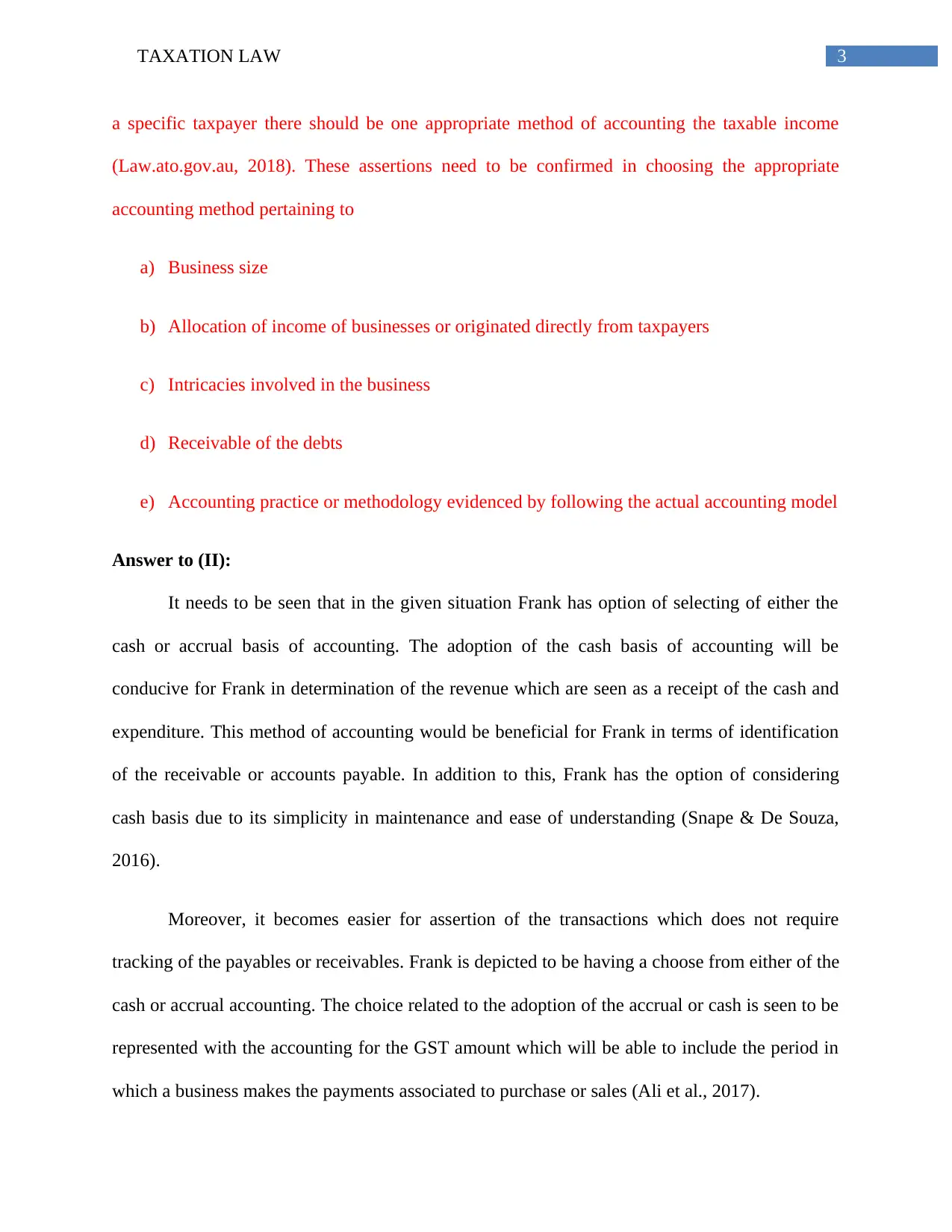
3TAXATION LAW
a specific taxpayer there should be one appropriate method of accounting the taxable income
(Law.ato.gov.au, 2018). These assertions need to be confirmed in choosing the appropriate
accounting method pertaining to
a) Business size
b) Allocation of income of businesses or originated directly from taxpayers
c) Intricacies involved in the business
d) Receivable of the debts
e) Accounting practice or methodology evidenced by following the actual accounting model
Answer to (II):
It needs to be seen that in the given situation Frank has option of selecting of either the
cash or accrual basis of accounting. The adoption of the cash basis of accounting will be
conducive for Frank in determination of the revenue which are seen as a receipt of the cash and
expenditure. This method of accounting would be beneficial for Frank in terms of identification
of the receivable or accounts payable. In addition to this, Frank has the option of considering
cash basis due to its simplicity in maintenance and ease of understanding (Snape & De Souza,
2016).
Moreover, it becomes easier for assertion of the transactions which does not require
tracking of the payables or receivables. Frank is depicted to be having a choose from either of the
cash or accrual accounting. The choice related to the adoption of the accrual or cash is seen to be
represented with the accounting for the GST amount which will be able to include the period in
which a business makes the payments associated to purchase or sales (Ali et al., 2017).
a specific taxpayer there should be one appropriate method of accounting the taxable income
(Law.ato.gov.au, 2018). These assertions need to be confirmed in choosing the appropriate
accounting method pertaining to
a) Business size
b) Allocation of income of businesses or originated directly from taxpayers
c) Intricacies involved in the business
d) Receivable of the debts
e) Accounting practice or methodology evidenced by following the actual accounting model
Answer to (II):
It needs to be seen that in the given situation Frank has option of selecting of either the
cash or accrual basis of accounting. The adoption of the cash basis of accounting will be
conducive for Frank in determination of the revenue which are seen as a receipt of the cash and
expenditure. This method of accounting would be beneficial for Frank in terms of identification
of the receivable or accounts payable. In addition to this, Frank has the option of considering
cash basis due to its simplicity in maintenance and ease of understanding (Snape & De Souza,
2016).
Moreover, it becomes easier for assertion of the transactions which does not require
tracking of the payables or receivables. Frank is depicted to be having a choose from either of the
cash or accrual accounting. The choice related to the adoption of the accrual or cash is seen to be
represented with the accounting for the GST amount which will be able to include the period in
which a business makes the payments associated to purchase or sales (Ali et al., 2017).
Paraphrase This Document
Need a fresh take? Get an instant paraphrase of this document with our AI Paraphraser

4TAXATION LAW
The decision is passed in the court for “Carden v FCT” relates to the accounting method
which shall provide the appropriate view of true income pertaining to the taxpayer. On the
contrary, Henderson v FCT” ruled that the correct method of assertion for taxable income needs
to be considered with the accrual basis of accounting. Referring to the case of “Henderson v
FCT” accrual accounting basis is seen to be appropriate for Frank despite of his liberty in
choosing the accounting basis for recognising revenue (Ato.gov.au, 2018).
Answer to (III):
As per the given situation the commissioner of the taxation is seen to be having the rights
of insisting a certain method of accounting. In addition to this, the taxation commissioner has
stated that the person held assessable for taxation needs to be depicted in terms of the payments
which are received as per the business irrespective of the work performed. In such a
circumstance the commissioner under the cash basis of accounting will include the payments
which are received as a result of the taxable income. The commissioner of taxation has further
included the business aspects as per the total left in the previous year, which was less than $ 10
million for a particular account as per the GST and the cash method of accounting.
The counting as per the cash method will be also able to account for the business
activities which will cover the payments made for the purchase and sales. It needs to be also
discerned that the commissioner of taxation has insisted on gaining the advantage as per cash
concept of accounting which will be helpful for the business in the better alignment of the of the
liabilities of the activity statement and also easier cash flow monitoring (Braverman, Marsden &
Sadiq, 2015).
The decision is passed in the court for “Carden v FCT” relates to the accounting method
which shall provide the appropriate view of true income pertaining to the taxpayer. On the
contrary, Henderson v FCT” ruled that the correct method of assertion for taxable income needs
to be considered with the accrual basis of accounting. Referring to the case of “Henderson v
FCT” accrual accounting basis is seen to be appropriate for Frank despite of his liberty in
choosing the accounting basis for recognising revenue (Ato.gov.au, 2018).
Answer to (III):
As per the given situation the commissioner of the taxation is seen to be having the rights
of insisting a certain method of accounting. In addition to this, the taxation commissioner has
stated that the person held assessable for taxation needs to be depicted in terms of the payments
which are received as per the business irrespective of the work performed. In such a
circumstance the commissioner under the cash basis of accounting will include the payments
which are received as a result of the taxable income. The commissioner of taxation has further
included the business aspects as per the total left in the previous year, which was less than $ 10
million for a particular account as per the GST and the cash method of accounting.
The counting as per the cash method will be also able to account for the business
activities which will cover the payments made for the purchase and sales. It needs to be also
discerned that the commissioner of taxation has insisted on gaining the advantage as per cash
concept of accounting which will be helpful for the business in the better alignment of the of the
liabilities of the activity statement and also easier cash flow monitoring (Braverman, Marsden &
Sadiq, 2015).
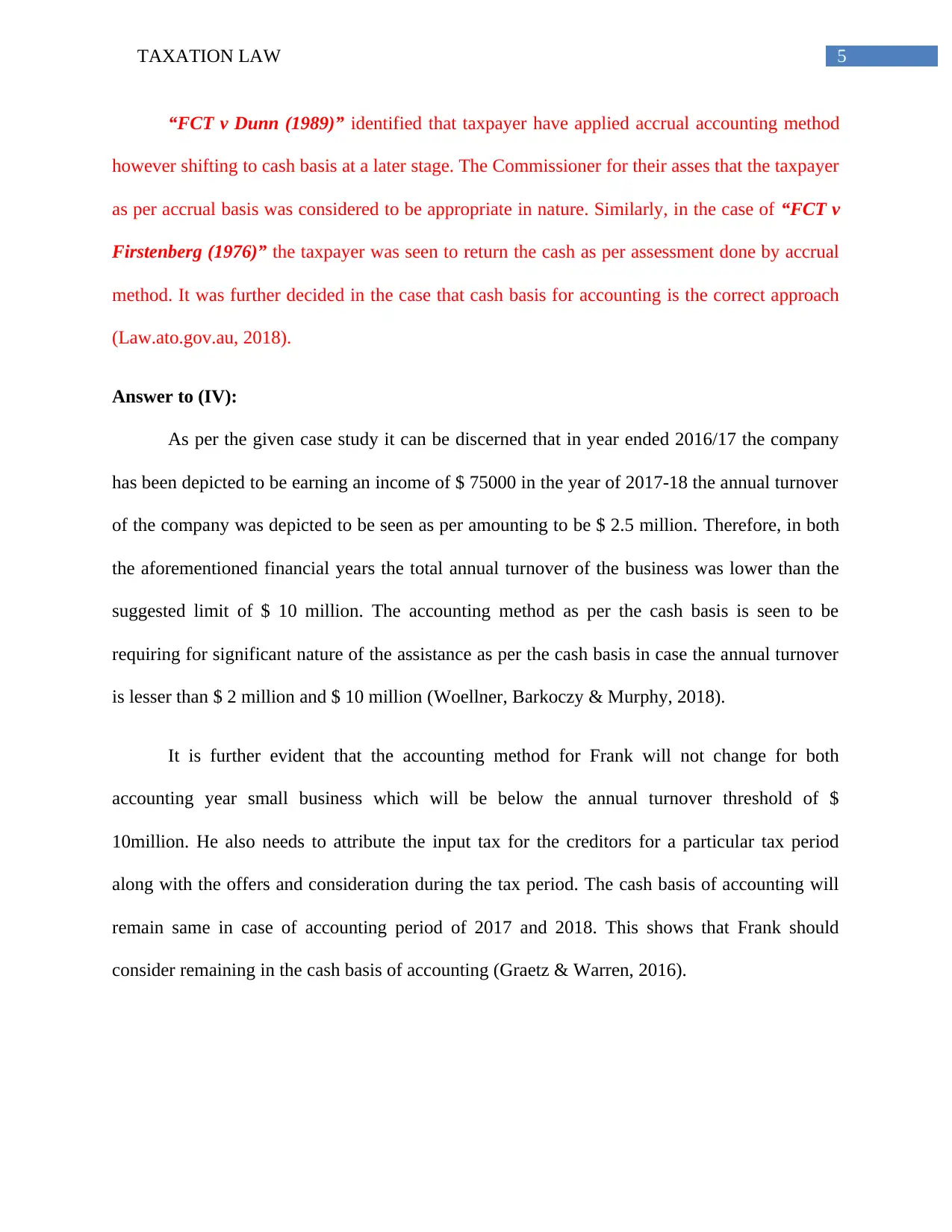
5TAXATION LAW
“FCT v Dunn (1989)” identified that taxpayer have applied accrual accounting method
however shifting to cash basis at a later stage. The Commissioner for their asses that the taxpayer
as per accrual basis was considered to be appropriate in nature. Similarly, in the case of “FCT v
Firstenberg (1976)” the taxpayer was seen to return the cash as per assessment done by accrual
method. It was further decided in the case that cash basis for accounting is the correct approach
(Law.ato.gov.au, 2018).
Answer to (IV):
As per the given case study it can be discerned that in year ended 2016/17 the company
has been depicted to be earning an income of $ 75000 in the year of 2017-18 the annual turnover
of the company was depicted to be seen as per amounting to be $ 2.5 million. Therefore, in both
the aforementioned financial years the total annual turnover of the business was lower than the
suggested limit of $ 10 million. The accounting method as per the cash basis is seen to be
requiring for significant nature of the assistance as per the cash basis in case the annual turnover
is lesser than $ 2 million and $ 10 million (Woellner, Barkoczy & Murphy, 2018).
It is further evident that the accounting method for Frank will not change for both
accounting year small business which will be below the annual turnover threshold of $
10million. He also needs to attribute the input tax for the creditors for a particular tax period
along with the offers and consideration during the tax period. The cash basis of accounting will
remain same in case of accounting period of 2017 and 2018. This shows that Frank should
consider remaining in the cash basis of accounting (Graetz & Warren, 2016).
“FCT v Dunn (1989)” identified that taxpayer have applied accrual accounting method
however shifting to cash basis at a later stage. The Commissioner for their asses that the taxpayer
as per accrual basis was considered to be appropriate in nature. Similarly, in the case of “FCT v
Firstenberg (1976)” the taxpayer was seen to return the cash as per assessment done by accrual
method. It was further decided in the case that cash basis for accounting is the correct approach
(Law.ato.gov.au, 2018).
Answer to (IV):
As per the given case study it can be discerned that in year ended 2016/17 the company
has been depicted to be earning an income of $ 75000 in the year of 2017-18 the annual turnover
of the company was depicted to be seen as per amounting to be $ 2.5 million. Therefore, in both
the aforementioned financial years the total annual turnover of the business was lower than the
suggested limit of $ 10 million. The accounting method as per the cash basis is seen to be
requiring for significant nature of the assistance as per the cash basis in case the annual turnover
is lesser than $ 2 million and $ 10 million (Woellner, Barkoczy & Murphy, 2018).
It is further evident that the accounting method for Frank will not change for both
accounting year small business which will be below the annual turnover threshold of $
10million. He also needs to attribute the input tax for the creditors for a particular tax period
along with the offers and consideration during the tax period. The cash basis of accounting will
remain same in case of accounting period of 2017 and 2018. This shows that Frank should
consider remaining in the cash basis of accounting (Graetz & Warren, 2016).
⊘ This is a preview!⊘
Do you want full access?
Subscribe today to unlock all pages.

Trusted by 1+ million students worldwide
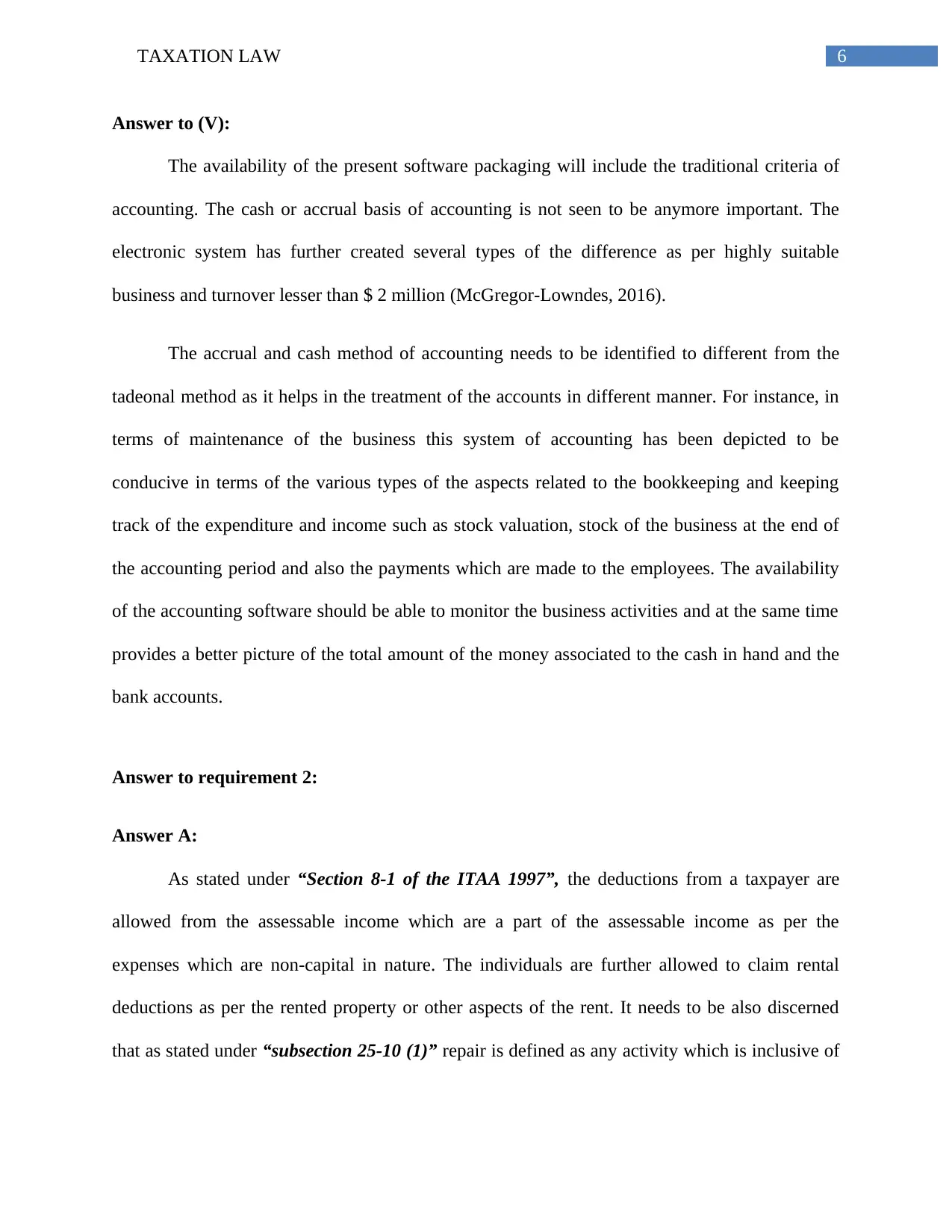
6TAXATION LAW
Answer to (V):
The availability of the present software packaging will include the traditional criteria of
accounting. The cash or accrual basis of accounting is not seen to be anymore important. The
electronic system has further created several types of the difference as per highly suitable
business and turnover lesser than $ 2 million (McGregor-Lowndes, 2016).
The accrual and cash method of accounting needs to be identified to different from the
tadeonal method as it helps in the treatment of the accounts in different manner. For instance, in
terms of maintenance of the business this system of accounting has been depicted to be
conducive in terms of the various types of the aspects related to the bookkeeping and keeping
track of the expenditure and income such as stock valuation, stock of the business at the end of
the accounting period and also the payments which are made to the employees. The availability
of the accounting software should be able to monitor the business activities and at the same time
provides a better picture of the total amount of the money associated to the cash in hand and the
bank accounts.
Answer to requirement 2:
Answer A:
As stated under “Section 8-1 of the ITAA 1997”, the deductions from a taxpayer are
allowed from the assessable income which are a part of the assessable income as per the
expenses which are non-capital in nature. The individuals are further allowed to claim rental
deductions as per the rented property or other aspects of the rent. It needs to be also discerned
that as stated under “subsection 25-10 (1)” repair is defined as any activity which is inclusive of
Answer to (V):
The availability of the present software packaging will include the traditional criteria of
accounting. The cash or accrual basis of accounting is not seen to be anymore important. The
electronic system has further created several types of the difference as per highly suitable
business and turnover lesser than $ 2 million (McGregor-Lowndes, 2016).
The accrual and cash method of accounting needs to be identified to different from the
tadeonal method as it helps in the treatment of the accounts in different manner. For instance, in
terms of maintenance of the business this system of accounting has been depicted to be
conducive in terms of the various types of the aspects related to the bookkeeping and keeping
track of the expenditure and income such as stock valuation, stock of the business at the end of
the accounting period and also the payments which are made to the employees. The availability
of the accounting software should be able to monitor the business activities and at the same time
provides a better picture of the total amount of the money associated to the cash in hand and the
bank accounts.
Answer to requirement 2:
Answer A:
As stated under “Section 8-1 of the ITAA 1997”, the deductions from a taxpayer are
allowed from the assessable income which are a part of the assessable income as per the
expenses which are non-capital in nature. The individuals are further allowed to claim rental
deductions as per the rented property or other aspects of the rent. It needs to be also discerned
that as stated under “subsection 25-10 (1)” repair is defined as any activity which is inclusive of
Paraphrase This Document
Need a fresh take? Get an instant paraphrase of this document with our AI Paraphraser

7TAXATION LAW
the restoration of the assets to their previous conditions without the necessary function or
character (Cao et al., 2015).
The repairs may be considered with the replacement and replacement as per the
subsidiary portions of the reconstruction. Such a cost will be based on replacing the fittings of
the kitchen and deteriorated cupboard which is seen as per the deductions under “section 8-1 of
the ITAA 1997”. These repairs are further constituted as per the general repairs relating to which
the deductions may be claimed. The repairs are further seen to be based on restoring of the
function and efficiency of the asset and improvement in the character (Taylor et al., 2018).
Answer B:
The legal expenditures incurred are needed to be considered as per the deductible income.
These costs are seen to comprise of the non-paying tenant taken by any court which may lead to
loss of income and claimable for rental deduction required for deducting the claims associated to
the injuries suffered by the third party associated to the rental property. In most of the situation
the legal expenditure of capital in nature are non-deductible. The non-deductible legal
expenditures may be of capital nature but they are considered as a part of the cost of the property
pertaining to the CGT (Braithwaite, Reinhart & Job, 2018).
In the given case Ruby has reported the legal expenditure as $ 7,000 as a tenant met with
an accident on the steps and suffered injuries, the legal expense of $ 7000 will be adjusted with
the deductions as the expenses are consisting of the defending for the damages claims as a result
of the injuries sustained on a rental property. In addition to this, the expenditure from letting out
the premises to the tenant was depicted with the motive for generating assessable income.
Moreover. The legal expenditure were a result of the Ruby’s possession of the rental income
the restoration of the assets to their previous conditions without the necessary function or
character (Cao et al., 2015).
The repairs may be considered with the replacement and replacement as per the
subsidiary portions of the reconstruction. Such a cost will be based on replacing the fittings of
the kitchen and deteriorated cupboard which is seen as per the deductions under “section 8-1 of
the ITAA 1997”. These repairs are further constituted as per the general repairs relating to which
the deductions may be claimed. The repairs are further seen to be based on restoring of the
function and efficiency of the asset and improvement in the character (Taylor et al., 2018).
Answer B:
The legal expenditures incurred are needed to be considered as per the deductible income.
These costs are seen to comprise of the non-paying tenant taken by any court which may lead to
loss of income and claimable for rental deduction required for deducting the claims associated to
the injuries suffered by the third party associated to the rental property. In most of the situation
the legal expenditure of capital in nature are non-deductible. The non-deductible legal
expenditures may be of capital nature but they are considered as a part of the cost of the property
pertaining to the CGT (Braithwaite, Reinhart & Job, 2018).
In the given case Ruby has reported the legal expenditure as $ 7,000 as a tenant met with
an accident on the steps and suffered injuries, the legal expense of $ 7000 will be adjusted with
the deductions as the expenses are consisting of the defending for the damages claims as a result
of the injuries sustained on a rental property. In addition to this, the expenditure from letting out
the premises to the tenant was depicted with the motive for generating assessable income.
Moreover. The legal expenditure were a result of the Ruby’s possession of the rental income

8TAXATION LAW
which is held incidental as per producing of the taxable rental income. There has been no scope
of enduring benefit as per the benefits which was expenses appropriate with the revenue account.
Answer C:
As stated under “section 8-1 of the ITAA 1997” the various types of the deductions
allowed under the outgoing losses have occurred as a result of the income which is taxable and
excluding the circumstances in which there has been losses or outgoings which are capital in
nature and associated to the computation of the exempted income. As decided in the case of
“Hallstroms Pty Ltd v FCT (1946)” of ascertaining whether deductions as per the legal
expenditure can be allowed as per the provision of “section 8-1 of the ITAA 1997”, the nature of
the expenditure needs to be taken into account. In the present situation it has been further evident
that Ruby Pty Ltd mainly suffered the expenses as result of the compensation for the damages.
The claim settlement amount was seen as $750,000 pertaining to the manufacturing of the car
(Frecknall-Hughes & Kirchler, 2015).
In the findings of the “Sun Newspaper Ltd v FCT (1938)” stated for the expenditures
which were related in the direction of the structural changes rather than the operational purpose
and capital in nature along with the non-allowable deductions. The compensation was further
taken into account as per the operational purpose. The expenditure is seen to be concerning
towards the operational and structural purpose. As the expenses are seen to be capital in nature
they will not be allowed for the deductions for Ruby Pty Ltd.
Answer D:
As per the statement of Australian taxation office, expenditure is seen as a non-
allowable deduction for an eligible period. In order to obtain the deduction as per section 63of
which is held incidental as per producing of the taxable rental income. There has been no scope
of enduring benefit as per the benefits which was expenses appropriate with the revenue account.
Answer C:
As stated under “section 8-1 of the ITAA 1997” the various types of the deductions
allowed under the outgoing losses have occurred as a result of the income which is taxable and
excluding the circumstances in which there has been losses or outgoings which are capital in
nature and associated to the computation of the exempted income. As decided in the case of
“Hallstroms Pty Ltd v FCT (1946)” of ascertaining whether deductions as per the legal
expenditure can be allowed as per the provision of “section 8-1 of the ITAA 1997”, the nature of
the expenditure needs to be taken into account. In the present situation it has been further evident
that Ruby Pty Ltd mainly suffered the expenses as result of the compensation for the damages.
The claim settlement amount was seen as $750,000 pertaining to the manufacturing of the car
(Frecknall-Hughes & Kirchler, 2015).
In the findings of the “Sun Newspaper Ltd v FCT (1938)” stated for the expenditures
which were related in the direction of the structural changes rather than the operational purpose
and capital in nature along with the non-allowable deductions. The compensation was further
taken into account as per the operational purpose. The expenditure is seen to be concerning
towards the operational and structural purpose. As the expenses are seen to be capital in nature
they will not be allowed for the deductions for Ruby Pty Ltd.
Answer D:
As per the statement of Australian taxation office, expenditure is seen as a non-
allowable deduction for an eligible period. In order to obtain the deduction as per section 63of
⊘ This is a preview!⊘
Do you want full access?
Subscribe today to unlock all pages.

Trusted by 1+ million students worldwide
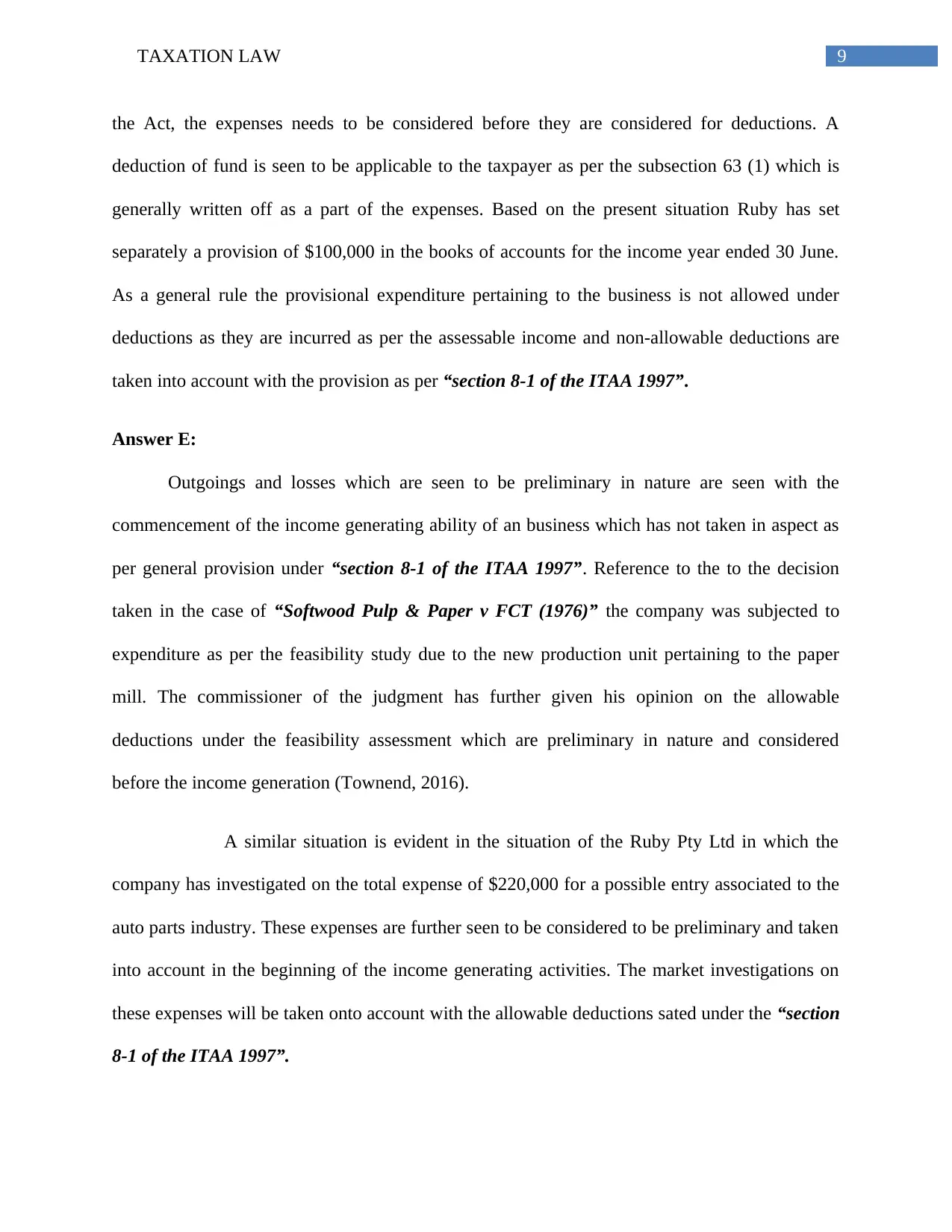
9TAXATION LAW
the Act, the expenses needs to be considered before they are considered for deductions. A
deduction of fund is seen to be applicable to the taxpayer as per the subsection 63 (1) which is
generally written off as a part of the expenses. Based on the present situation Ruby has set
separately a provision of $100,000 in the books of accounts for the income year ended 30 June.
As a general rule the provisional expenditure pertaining to the business is not allowed under
deductions as they are incurred as per the assessable income and non-allowable deductions are
taken into account with the provision as per “section 8-1 of the ITAA 1997”.
Answer E:
Outgoings and losses which are seen to be preliminary in nature are seen with the
commencement of the income generating ability of an business which has not taken in aspect as
per general provision under “section 8-1 of the ITAA 1997”. Reference to the to the decision
taken in the case of “Softwood Pulp & Paper v FCT (1976)” the company was subjected to
expenditure as per the feasibility study due to the new production unit pertaining to the paper
mill. The commissioner of the judgment has further given his opinion on the allowable
deductions under the feasibility assessment which are preliminary in nature and considered
before the income generation (Townend, 2016).
A similar situation is evident in the situation of the Ruby Pty Ltd in which the
company has investigated on the total expense of $220,000 for a possible entry associated to the
auto parts industry. These expenses are further seen to be considered to be preliminary and taken
into account in the beginning of the income generating activities. The market investigations on
these expenses will be taken onto account with the allowable deductions sated under the “section
8-1 of the ITAA 1997”.
the Act, the expenses needs to be considered before they are considered for deductions. A
deduction of fund is seen to be applicable to the taxpayer as per the subsection 63 (1) which is
generally written off as a part of the expenses. Based on the present situation Ruby has set
separately a provision of $100,000 in the books of accounts for the income year ended 30 June.
As a general rule the provisional expenditure pertaining to the business is not allowed under
deductions as they are incurred as per the assessable income and non-allowable deductions are
taken into account with the provision as per “section 8-1 of the ITAA 1997”.
Answer E:
Outgoings and losses which are seen to be preliminary in nature are seen with the
commencement of the income generating ability of an business which has not taken in aspect as
per general provision under “section 8-1 of the ITAA 1997”. Reference to the to the decision
taken in the case of “Softwood Pulp & Paper v FCT (1976)” the company was subjected to
expenditure as per the feasibility study due to the new production unit pertaining to the paper
mill. The commissioner of the judgment has further given his opinion on the allowable
deductions under the feasibility assessment which are preliminary in nature and considered
before the income generation (Townend, 2016).
A similar situation is evident in the situation of the Ruby Pty Ltd in which the
company has investigated on the total expense of $220,000 for a possible entry associated to the
auto parts industry. These expenses are further seen to be considered to be preliminary and taken
into account in the beginning of the income generating activities. The market investigations on
these expenses will be taken onto account with the allowable deductions sated under the “section
8-1 of the ITAA 1997”.
Paraphrase This Document
Need a fresh take? Get an instant paraphrase of this document with our AI Paraphraser
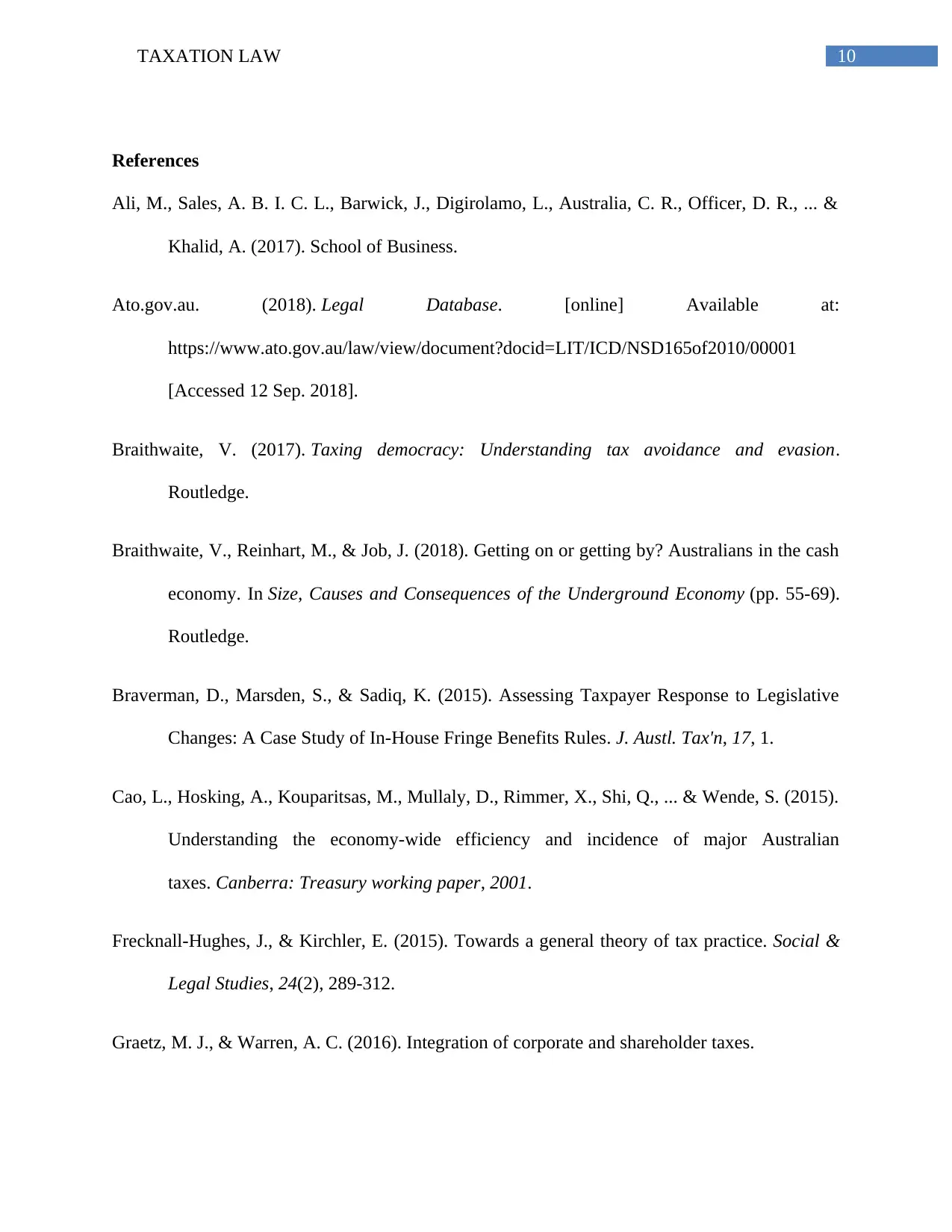
10TAXATION LAW
References
Ali, M., Sales, A. B. I. C. L., Barwick, J., Digirolamo, L., Australia, C. R., Officer, D. R., ... &
Khalid, A. (2017). School of Business.
Ato.gov.au. (2018). Legal Database. [online] Available at:
https://www.ato.gov.au/law/view/document?docid=LIT/ICD/NSD165of2010/00001
[Accessed 12 Sep. 2018].
Braithwaite, V. (2017). Taxing democracy: Understanding tax avoidance and evasion.
Routledge.
Braithwaite, V., Reinhart, M., & Job, J. (2018). Getting on or getting by? Australians in the cash
economy. In Size, Causes and Consequences of the Underground Economy (pp. 55-69).
Routledge.
Braverman, D., Marsden, S., & Sadiq, K. (2015). Assessing Taxpayer Response to Legislative
Changes: A Case Study of In-House Fringe Benefits Rules. J. Austl. Tax'n, 17, 1.
Cao, L., Hosking, A., Kouparitsas, M., Mullaly, D., Rimmer, X., Shi, Q., ... & Wende, S. (2015).
Understanding the economy-wide efficiency and incidence of major Australian
taxes. Canberra: Treasury working paper, 2001.
Frecknall-Hughes, J., & Kirchler, E. (2015). Towards a general theory of tax practice. Social &
Legal Studies, 24(2), 289-312.
Graetz, M. J., & Warren, A. C. (2016). Integration of corporate and shareholder taxes.
References
Ali, M., Sales, A. B. I. C. L., Barwick, J., Digirolamo, L., Australia, C. R., Officer, D. R., ... &
Khalid, A. (2017). School of Business.
Ato.gov.au. (2018). Legal Database. [online] Available at:
https://www.ato.gov.au/law/view/document?docid=LIT/ICD/NSD165of2010/00001
[Accessed 12 Sep. 2018].
Braithwaite, V. (2017). Taxing democracy: Understanding tax avoidance and evasion.
Routledge.
Braithwaite, V., Reinhart, M., & Job, J. (2018). Getting on or getting by? Australians in the cash
economy. In Size, Causes and Consequences of the Underground Economy (pp. 55-69).
Routledge.
Braverman, D., Marsden, S., & Sadiq, K. (2015). Assessing Taxpayer Response to Legislative
Changes: A Case Study of In-House Fringe Benefits Rules. J. Austl. Tax'n, 17, 1.
Cao, L., Hosking, A., Kouparitsas, M., Mullaly, D., Rimmer, X., Shi, Q., ... & Wende, S. (2015).
Understanding the economy-wide efficiency and incidence of major Australian
taxes. Canberra: Treasury working paper, 2001.
Frecknall-Hughes, J., & Kirchler, E. (2015). Towards a general theory of tax practice. Social &
Legal Studies, 24(2), 289-312.
Graetz, M. J., & Warren, A. C. (2016). Integration of corporate and shareholder taxes.
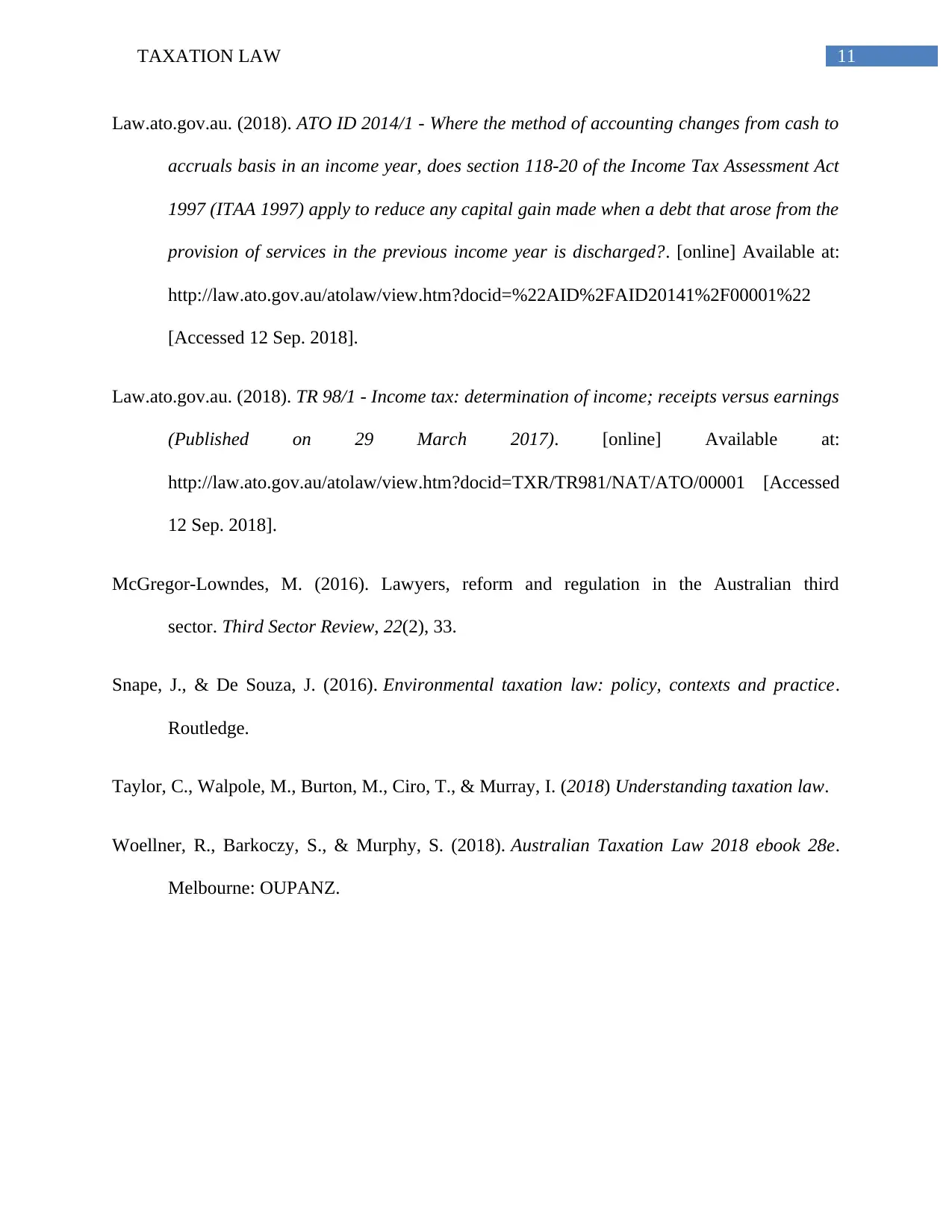
11TAXATION LAW
Law.ato.gov.au. (2018). ATO ID 2014/1 - Where the method of accounting changes from cash to
accruals basis in an income year, does section 118-20 of the Income Tax Assessment Act
1997 (ITAA 1997) apply to reduce any capital gain made when a debt that arose from the
provision of services in the previous income year is discharged?. [online] Available at:
http://law.ato.gov.au/atolaw/view.htm?docid=%22AID%2FAID20141%2F00001%22
[Accessed 12 Sep. 2018].
Law.ato.gov.au. (2018). TR 98/1 - Income tax: determination of income; receipts versus earnings
(Published on 29 March 2017). [online] Available at:
http://law.ato.gov.au/atolaw/view.htm?docid=TXR/TR981/NAT/ATO/00001 [Accessed
12 Sep. 2018].
McGregor-Lowndes, M. (2016). Lawyers, reform and regulation in the Australian third
sector. Third Sector Review, 22(2), 33.
Snape, J., & De Souza, J. (2016). Environmental taxation law: policy, contexts and practice.
Routledge.
Taylor, C., Walpole, M., Burton, M., Ciro, T., & Murray, I. (2018) Understanding taxation law.
Woellner, R., Barkoczy, S., & Murphy, S. (2018). Australian Taxation Law 2018 ebook 28e.
Melbourne: OUPANZ.
Law.ato.gov.au. (2018). ATO ID 2014/1 - Where the method of accounting changes from cash to
accruals basis in an income year, does section 118-20 of the Income Tax Assessment Act
1997 (ITAA 1997) apply to reduce any capital gain made when a debt that arose from the
provision of services in the previous income year is discharged?. [online] Available at:
http://law.ato.gov.au/atolaw/view.htm?docid=%22AID%2FAID20141%2F00001%22
[Accessed 12 Sep. 2018].
Law.ato.gov.au. (2018). TR 98/1 - Income tax: determination of income; receipts versus earnings
(Published on 29 March 2017). [online] Available at:
http://law.ato.gov.au/atolaw/view.htm?docid=TXR/TR981/NAT/ATO/00001 [Accessed
12 Sep. 2018].
McGregor-Lowndes, M. (2016). Lawyers, reform and regulation in the Australian third
sector. Third Sector Review, 22(2), 33.
Snape, J., & De Souza, J. (2016). Environmental taxation law: policy, contexts and practice.
Routledge.
Taylor, C., Walpole, M., Burton, M., Ciro, T., & Murray, I. (2018) Understanding taxation law.
Woellner, R., Barkoczy, S., & Murphy, S. (2018). Australian Taxation Law 2018 ebook 28e.
Melbourne: OUPANZ.
⊘ This is a preview!⊘
Do you want full access?
Subscribe today to unlock all pages.

Trusted by 1+ million students worldwide
1 out of 12
Related Documents
Your All-in-One AI-Powered Toolkit for Academic Success.
+13062052269
info@desklib.com
Available 24*7 on WhatsApp / Email
![[object Object]](/_next/static/media/star-bottom.7253800d.svg)
Unlock your academic potential
Copyright © 2020–2025 A2Z Services. All Rights Reserved. Developed and managed by ZUCOL.



